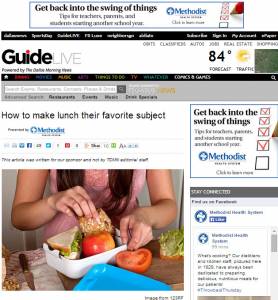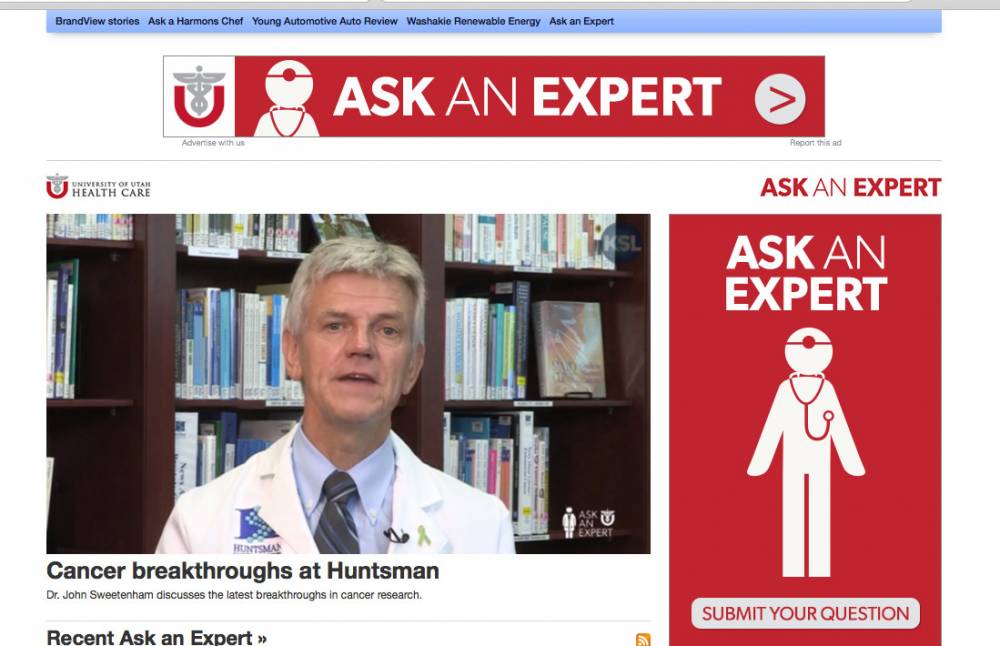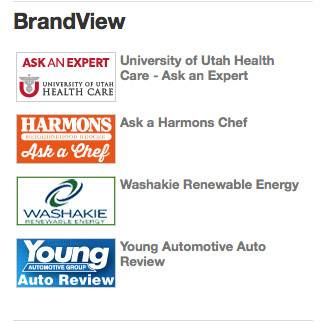Round-up of examples of local native ad units
Examples of how to label, promote and house units from top local media companies
Native advertising is generally considered to be paid content written and displayed to resemble the editorial content of a media brand.
All local executives of successful programs we interviewed agree that native editorial needs to meet and exceed readers expectations regarding quality, voice and values.
But how this content is displayed varies from program to program.
Local Media Insider surveyed more than ten local native programs from around the country to provide visual examples of use cases and the concepts behind them.
The round-up includes only "native" programs written by the media company's writers. Specifically excluded are examples in which advertiser-written articles and business profiles are "surfaced" and promoted on the rail of high traffic pages.
Also excluded are partially native niche sites, such as dining, weddings or travel, which contain a mix that is often un-labeled and designed primarily for search, as well as Ask an Expert segments on television shows, packaged with digital niche content.
Finally, we also excluded related story content provided by external companies and distributed on local media sites via related story widgets.
Within the group of media-written native ads running in-stream on high traffic pages, we looked at how media are addressing the following issues:
1. On which page are native ads promoted, where and how long?
2. How are the promotions are labeled?
3. How is the article page formatted and what goes on the right and left rail?
4. Where is the content hosted?
5. How else is native promoted?
Below are examples of how local media around the country have answered each of these questions.
1. On which page and where on the page do native ads run?
Like national companies such as BuzzFeed, the original innovator in native programs, local media typically place ads in-stream on the highest trafficked news page, typically the home page.
Local media with multiple sites typically placed native on only one brand. The San Francisco Chronicle places native only on SFgate.com (originally the events and search site) not SFChronicle.com and Deseret Digital places all its native on the television site, KSL.com rather than its newspaper site.
One example in our survey, the Dallas Morning News, promotes its native ads on a sub-channel, "Events Guide," rather than the home page.
A factor to consider is the importance of direct traffic versus search traffic to the advertiser; some sites have higher search value but lower direct traffic, and vice versa.
However, if the value proposition is branding and thought leadership, the highest amount of traffic in the most prestigious editorial page - the home page - is the common choice.
Location on the page
There are just a few locational options on the page to consider: left rail, center or right rail; below or above the fold; fixed position in the stream or migrating through with the rest of the news stories.
Most programs locate the articles in-stream, however, a few place native ads on the right rail where the ads and promotions are located. Keep in mind that statistic show above the fold click through will always be higher.
Below is the classic in-stream article promotion advanced by BuzzFeed, at the top of the page, which competes with - and sometimes exceeds the traffic of - nearby news:

The Washington Post locates its native units on the left rail in a fixed position at bottom of the other stories:

This ad is "below the fold" but given the massive traffic and engagement on the Post's home page, there is plenty of traffic to go around. The core value proposition is running in the news stream beside the Washington Post's award-winning journalism.
The Dallas Morning News, on the other hand, runs ads in a right hand unit with other ads and promotions - and in its events guide, rather than on the home page:
The Quad City Times, a smaller paper based in Davenport, Iowa, places their ads in-stream in the coveted breaking news third column. They allow flexible placement, at the top of the stream, or moving through it.

These native ads may stay in-stream in the headline news area for six hours a day; some stay at the bottom, while some move around. In total the impressions on the home page are about 30,000 a day, so traffic is high enough to generate a good number of click-throughs to the story. A typical ad campaign, for say, the YMCA delivered enough page view in three days, in addition to search, for 23,000 article views.
But all-in-all, the program sells the value proposition of home page placement with the news.
"We position them as an expert in their field, on the home page of our site and riding along with the email blast. The visibility itself is more than just advertising; that's what they are buying." says Katie Wilson, until recently the Quad City Times' Digital Advertising Director.
A typical buy is $1,500 per article, with 12 stories running in 12 months. "It does not have to be once a month, could be four a month." (See also Pricing and packaging native ads).
Not all native ads run on newspaper sites. Deseret Digital posts its native ads on the TV giant KSL.com. Native ads on KSL.com run several times a day. For example, the University of Utah Healthcare ads run at 10 a.m., 2 p.m. and 9 p.m. in stream, traveling through the news queue as new articles are posted.
Here is another example of native ads formats on a TV comes from KOAA5 in Colorado Springs:

2. How are native ad promotions labeled?
As you can see from the above examples, there are a variety of labeling strategies from thick reverse banners in a different color, to highly subdued text headers that look like any news header. Almost all refer to native ads as "sponsored" in the labels. One sales director explained that this language makes it "easier to explain that is it not an advertorial, because the advertiser is not writing it."
While Polar, a native ad-serving platform, reports a small lift in click-through from a slight shading on native ads - which makes them look different form the media content - the trend seems to be from more aggressive labeling to more subdued labels.
The Naperville Sun, a community site belonging to the larger Chicago Sun Times Group, is an example of a more organic look; its native ads simply run in stream, no extra colors or separate placement, just the newspaper's own "native" design:

Part of the decision about look and feel has to do with the choice of how to deliver the ads. The Naperville Sun started their program in early 2014 by writing a couple of blogs on the client's directory page, then pushing this content into the news queue of the Word Press CMS.
If the newspaper is delivering the ads via its own CMS, it is more likely to use an organic label design - ie; changing only the wording but not colors and fonts.
Serving via the editorial CMS is simple and cheap, but reporting is often more difficult (see how three ways to serve native ads). If ads are delivered via the ad server, they are easier to track but typically served into the right rail where the other promotions run. Third parties such as Nativo solve this dilemna.
Another issue with labeling is the look and feel of the page when multiple native ads are running.
So far, the local media we looked at ran native ads one at a time on the home page.
But other national companies have found that aggressive labeling with banners - colored or otherwise and designed to promote full transparency - make the pages look zebra-striped when multiple sponsored posts are running. Even the New York Times is modifying its labels in favor of ones less likely to alter the look and feel of the overall brand.
3. How is the article page formatted and what goes on the right and left rail?
The landing page has a greater freedom of design and a variety of formats appear in the examples surveyed.
Native program directors had to answer the question: Is it more important to include more information about and for the client - but create more distinction between sponsored posts from news content - or is it more important that the formatting stay as "native" as possible?
Adding client banner ads to the right rail of their native ad article pages achieves additional clicks to the advertiser website, but make the ads look more like advertorials. So there are a few work arounds that address this issue.
Some decisions are made by restrictions of the content management system itself.
Since The Naperville Sun, for example, used the directory profile page for its blogs, the left rail has a "break out" of information about the customer.
Important links such as the address, phone number, map, and follow tools are also at the top of the article between the headline and the image:


If your company has a directory or guide-style profile page with blogging capability, hosting the article page on that platform will pick up all of these optimized links.
Clearly, the above article looks different than a news post, and it is well marked as "sponsored". The Naperville Sun plans to move towards a more traditional "news" look for its landing pages, as it reformats its' program to include promotional slots in-stream on the home page of the much larger Chicago Sun Times, its parent company.
Some media simply run standard right rail promotions on the native landing page, as in the native ad for a car dealer that runs on KOAA5, below.

Aside from the green label, the page looks just like any article on WOAA5.
A different, but more upscale look and feel for native article pages was created by The Washington Post's native program. The pages have a unique design, geared to look more like a magazine article than a traditional news article, with one huge image that covers the entire horizontal area:

At the Washington Post, like many programs, the content on the page is not always text but can include videos, slide shows, quizzes and other interactive web features.
The type of content is recommended to the client by the WP Brand Studio. In the above case, an infographic was selected as the best way to portray a comparison of American Tax laws with those of other countries, paid for by Fair Taxes for Growth:

The Post is also innovated in its use of the right rail of the native article page to promote other native ads from the same advertiser in standard, "related content" widgets.
Here's an example from "Guide to Graduate Education" sponsored by a variety of local universities:

But the most common treatement of the article page is to give all three units on the page to the advertiser.
Here's an example from The Dallas Morning News that features a combination of ad promotions and in-ad social feeds from the client site in this native post for the Methodist Health System:

With the article only periperally related to the advertiser, the extra space helps the brand "sink in" - and get extra clicks.
This approach is also used by KSL.com which typically sells all three ad units on the landing page to the client as part of the buy. The sales team promotes this as giving its' native clients "100% share of voice" on the page, and can also use ad impressions from each unit to in reports that show overall CPM :

4. Where and how are native ads hosted?
Most of the programs we looked at housed the campaigns on a "backdoor" URL where the articles remain for search purposes for at least year.
"BrandView," and "BrandConnect" programs each have an overall page that explains the program and houses all the brands.
Each brand campaign then has its own separate blog roll page, that acts as a channel with all of the articles for that "Brand."
These pages are rarely viewed by readers, but helpful to allow prospects to see and understand the program.
Here's an example of Deseret Digital's BrandView page :

The Washington Post's BrandConnect program has a more defined page that includes advertiser guidelines for placing native, a brief explanation of the program and a gallery of campaigns:

The 24 BrandConnect partners are portrayed in a highly visual display:

Clicking on any link takes the reader to a blog roll all of all the articles for the brand.
The exception to this approach is SpeakEasy, which house all of the native articles it writes on the client site. Their theory is that bringing readers back to the client site enhances the value to the advertiser. Most of the promotions are social, while native is considered "content marketing on steroids."
5. Additional promotions:
There are a variety of ways that native ad programs in the survey expand the reach of each article beyond time on the high traffic page.
• Promoting on other pages of the site. Many of the local programs from the Quad City Times to the Washington Post include promotions on other site areas.
BrandView also promotes all of its brands on the right rail of the home page. This way, when the ad is over, the articles not only stays live in the holding areas with the other recent BrandView articles, but the brand is also promoted in the static position on the right side of KSL's home page. Again, these are impressions to be counted and add to the CTR.

• Promoting via social posts, email and other audiences. Many media are promoting native via social media such as Twitter and Facebook, which poses an additional labeling challenge (how do you label a 140 character Twitter post?).
This side-door traffic can be an upsell or included in the original package. E-blasts for article headlines are also a popular way to extend the reach.
• Use of ad networks. Companies we talked to are still experimenting with promoted posts via ad networks to find what works best. Several brands have asked to pay for this kind of additional reach.
• Use of traditional media. Some native ad campaigns can be bundled with traditional media. TV sites have hosted related content in interviews and print companies have run native ads as "advertorial" style content.
The Quad City Times bolsters distribution of the ad with a quarter page print story, the same font as the newspaper, unlike old school advertorials, in which the font had to be different.

Conclusion and lessons learned
1.Most local native ads run on the home page where direct traffic is highest and part of the value chain is placement beside award-winning editorial.
2.Labeling is becoming more subdued as consumers become used to sponsored posts.
3. To take full advantage of the landing pages, programs utilize ad units and right hand positions for client ads or related native stories from the same client. This practice enhances the number of engagements as well as the number of impressions and the value of "100% share of voice."
4. There is a debate over whether to house native content on the media site where it has promotional value for selling new prospects, or on the client site, with most media opting for housing on their own sites. A few have named their programs (BrandConnect and BrandView) as well as their content creation teams (Brand Studio, BrandForge, Content and Design Center).
5. Almost all programs are looking at ways to scale up traffic to campaigns - and charge for it - via the media's internal audiences on social, email and other site areas, and via ad networks.
Many thanks to multiple top executives who contributed to this report and especially David Arkin, Gatehouse Media; Mike Orren, SpeakEasy; Katie Wilson; Ethan Selzer, Washington Post and Chris Lee and Toddy Handy, Deseret Digital. Any errors within this report are attributable to LocalMediaInsider alone.










